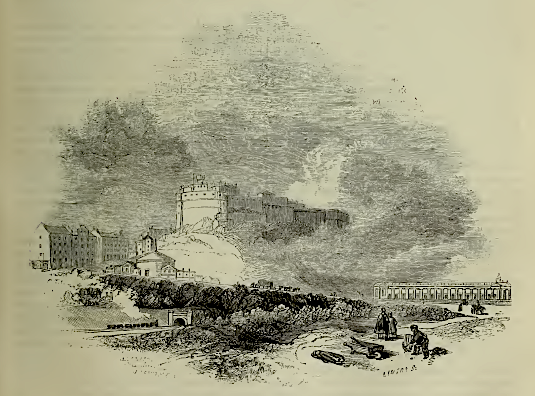
The leading lights of the Edinburgh Ladies’ Emancipation Society were the Quakers Jane Wigham (née Smeal) – sister of William Smeal of the Glasgow Emancipation Society – and her step-daughter Eliza Wigham. They had long awaited Douglass’ arrival. Already in November, while he was mid-way through his tour of Ireland, Jane wrote: ‘We hope to have Frederick Douglass in Scotland shortly.’1
While the brief report of the meeting, reproduced below, gives little detail of the speeches, it may serve as a reminder of the role of these women in the networks that sustained Douglass in Edinburgh in the intense weeks that followed – and later in the year when he returned. It is likely Douglass was a regular visitor to the Wigham household at 5 South Gray Street. And it is likely too that Jane and Eliza were the unnamed ‘ladies belonging to the Society of Friends’ who – according to the Witness newspaper – were observed assisting Douglass in carving the slogan ‘Send Back the Money’ on the slopes of Arthur’s Seat.2
LADIES’ MEETING IN MR. M’GILCHRIST’S CHURCH, ROSE STREET
Wednesday Evening, April 29
This meeting was most respectably attended, and was addressed by Messrs. Wright, Thompson, and Douglass, who respectively addressed the assembly upon the position and prospects of the Anti-Slavery cause, and the means which the women of this country had it in their power to employ for the good of those in bonds.
Mr. Wright reviewed the progress of the cause in America, and narrated the history of the Boston Anti-Slavery Society in Boston from the period of the famous mob of property and standing gentlemen in 1835, to the holding of the bazaar in Fanuil Hall in 1845. He concluded with an earnest and solemn exhortation.
Mr. THOMPSON dwelt largely upon the duty and desireableness of entering the Anti-Slavery cause in the true spirit of liberality, cheerfully and gratefully accepting the assistance and co-operation of all who sincerely loved the slave. He rejoiced that, in such a cause, persons of all denominations might labour together in har- [52] mony without sacrifice of principle, or any compromise of their destructive peculiarities. He described in touching terms the labours, fidelity, and unwavering zeal, of his friends in America, and called upon his hearers to esteem it a high privilege to be associated with such devoted fellow-labourers in the noble cause of human freedom.
Mr. DOUGLASS delivered a very effective speech, pointing out the great principles which united the abolitionists of America and sustained them, giving at once sublimity to their enterprise, and effect to their exertions.
All present seemed highly delighted with the proceedings of the meeting.
Free Church Alliance with Manstealers. Send Back the money. Great Anti-Slavery Meeting in the City Hall, Glasgow, Containing Speeches Delivered by Messrs. Wright, Douglass, and Buffum, from America, and by George Thompson, Esq. of London; with a Summary Account of a Series of Meetings Held in Edinburgh by the Above Named Gentlemen (Glasgow: George Gallie, 1846), pp. 51-52.
Notes
- Jane Wigham to Maria Weston Chapman, Edinburgh, 23 November 1845, repr. British and American Abolitionists: An Episode in Transatlantic Understanding, edited by Clare Taylor (Edinburgh: Edinburgh University Press, 1974), p. 244.
- Witness, 20 May 1846. See Scottish-American Graffiti for more details of this episode.